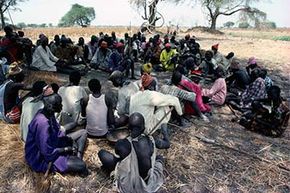What Are Some Folklore Genres?
Folklorists -- those who study folklore -- classify the subject according to various genres, or categories. The broadest categories are oral, material and belief [sources: Jaffe, University of Illinois at Urbana-Champaign]:
- Oral: One of the most popular folklore genres, oral folklore encompasses song, dance and all forms of "verbal art," including poetry, jokes, riddles, proverbs, fairy tales, myths and legends. Of course, many of these "verbal" art forms now exist in written form (e.g., fairy tales). But in the beginning, they were passed on orally. That's why many of them contain devices to help people remember them. One such device is repetition. Think of the story of the "Three Little Pigs," where the pigs keep building houses, which the wolf keeps saying, "I'll huff and I'll puff and I'll blow your house down." Folk tales also contain formulaic expressions to aid memory, such as "Once upon a time" and "They lived happily ever after."
- Material: Objects you can touch are included in the material folklore classification. So this means personal items such as home decorations, special clothing and jewelry. But it also encompasses traditional family recipes, foods and musical instruments -- e.g., the Sioux's chegah-skah-hdah, a type of rattle, and the bodhrán, an Irish frame drum. Vernacular artwork, textiles and architecture (using local materials and serving local needs) are also included in material folklore. Examples include the 1920s shotgun houses popular in the American South and the raised horreros, or granaries, found in Galicia, Spain.
- Belief: While this points to religion, belief also covers rituals such as tossing rice at a bride and groom to wish them good luck, and the Jewish tradition of giving bread, sugar and salt as a housewarming gift. Some folklorists classify this genre as behavioral or cogitative, and include the way folklore beliefs affect your thought process and behavior. Here's an example: A young driver rear-ends you, and you're about to tell her off. Then you remember the golden rule – "Do unto others as you would have them do unto you" -- and instead you calmly accept her apology. That's behavioral folklore in action.
Advertisement
